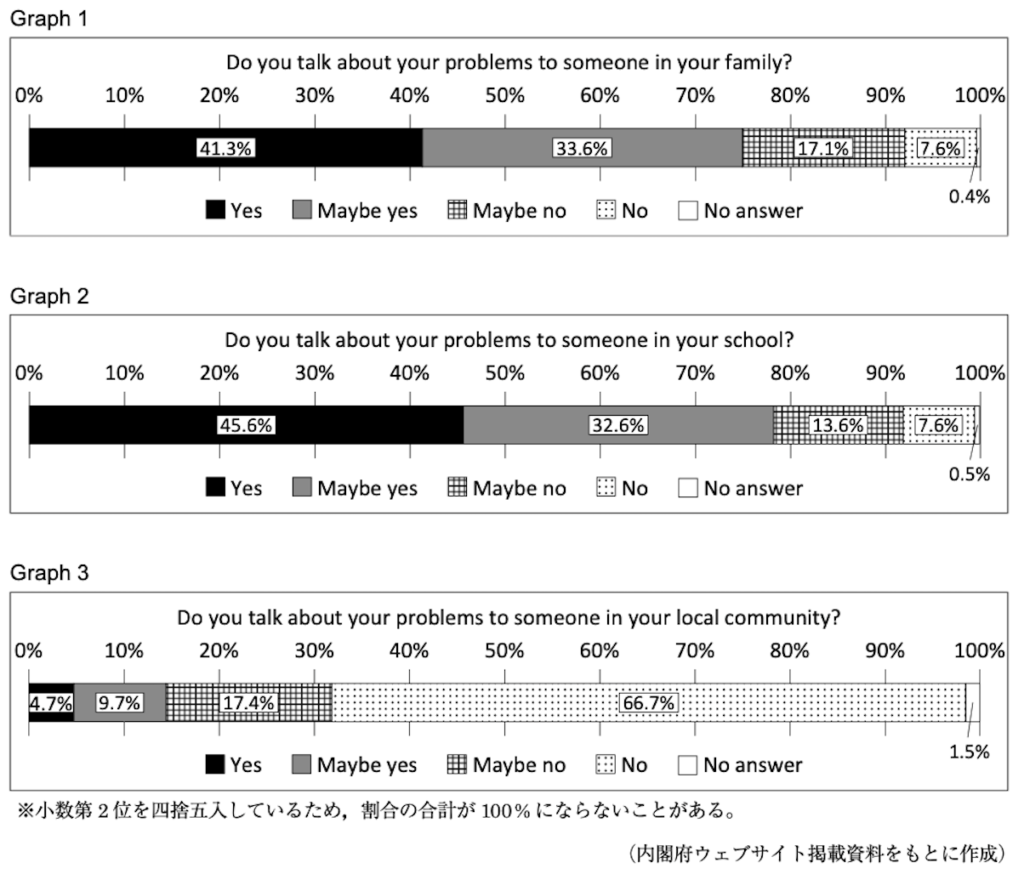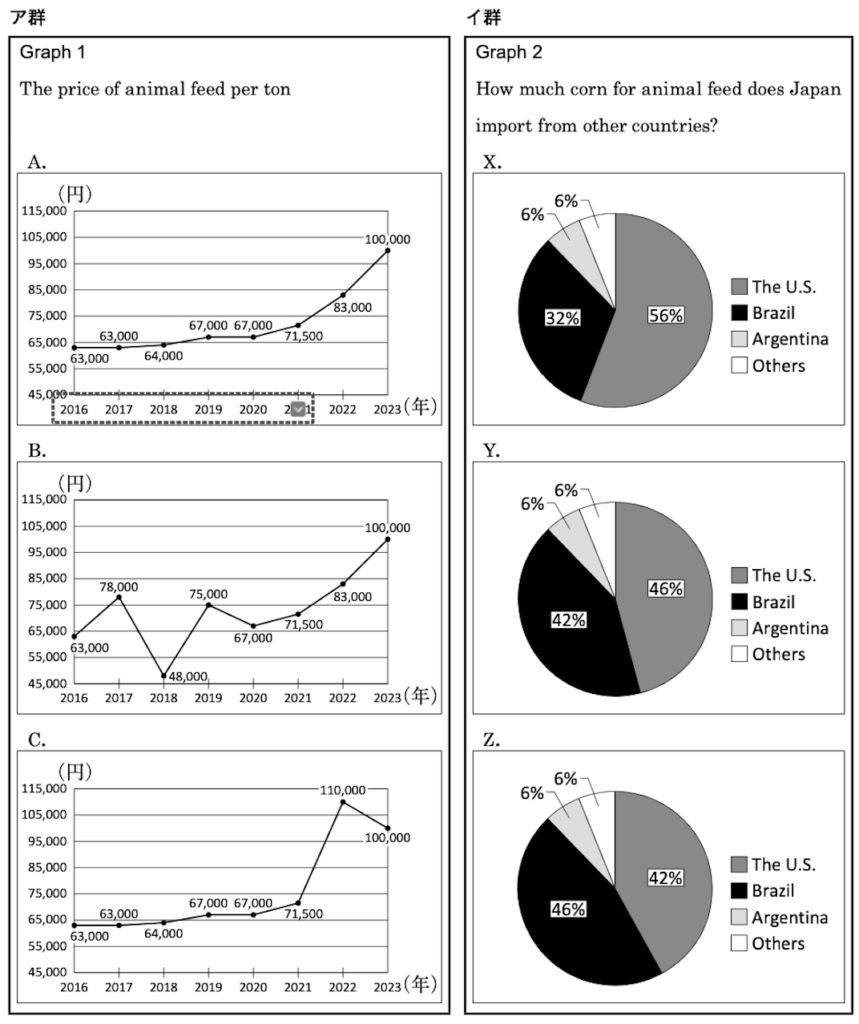最後に、傾向と対策・高校入試のしくみなどへのLINKがあります。
問2
次の(ア)~(ウ)の対話が完成するように,( ) の中に入れるのに最も適するものを、あとの1~4の中からそれぞれ一つずつ選び、その番号を答えなさい。
(ア) A : What happened after the Internet was ( )?
B: It became easier for people to get many kinds of information quickly.
1. developed
2. excused
3. gathered
4. reminded
正解:●●●
(イ) A : I heard you went to Kamome Museum last weekend.
B: Yes. I saw a popular ( ) made by a famous Japanese artist. I had a great time!
1. autumn
2. pleasure
3. statue
4. temperature
正解:●●●
(ウ) A : What are you the most ( ) of this year?
B : I got the first prize in the English speech contest! That was the best experience of this year!
1. bored
2. full
3. proud
4. tired
正解:●●●
問3
次の(ア)~(エ)の対話が完成するように,( )の中に入れるのに最も適するものを、あとの1~4の中からそれぞれ一つずつ選び、その番号を答えなさい。
(ア) A : Mr. Yamada, have all the students ( ) part in the basketball game finished their lunch yet?
B: Yes, they have.
1. take
2. taking
3. took
4. taken
正解:●●●
(イ) A: Would you like ( ) cup of tea?
B: No, thank you. Sorry, I have to leave soon.
1. its
2. both
3. another
4. some
正解:●●●
(ウ) A : Excuse me. Could you tell me the way to Momiji City Hall?
B: Yes. We are on Kamome Street right now. Go straight, and you will see Momiji Station on the left. The city hall is just ( ) the street from the station.
1. across
2. against
3. among
4. as
正解:●●●
(エ) A : That soccer game you’re watching on TV looks ( ). Did your favorite player get a goal?
B: Yes! He got two goals! Let’s watch the game together!
1. crying
2. exciting
3. interested
4. surprised
正解:●●●
問4
次の(ア)〜(エ)の対話が完成するように、( )内の六つの語の中から五つを選んで正しい順番に並べたとき、その( )内で3番目と5番目にくる話の番号をそれぞれ答えなさい。
(それぞれ一つずつ不要な語があるので,その語は使用しないこと。)
(ア) A: You are really good at English. Can you tell me (1. to 2. I 3. must 4. need 5. do 6. what ) to make a good English presentation?
B: Sorry. I’m good at English, but I’m not very good at making a presentation. Let’s ask Mr. Smith about it later.
正解:●●●
(イ) A : I’m going to go to Kamome City next week. Are there any good places you recommend?
B: Yes. One of (1. visit 2. tourists 3. time 4. places 5. should 6. the ) is Kamome Green Garden.
正解:●●●
(ウ) A : Do you ( 1. languages 2. are 3. is 4. think 5. learning 6. foreign ) important in your life?
B: Yes. I want to communicate with people from other countries and understand their feelings and opinions.
正解:●●●
(エ) A : Is there anything we can (1. make 2.our 3. for 4. city 5. do 6. to) cleaner?
B: Sure. We can pick up garbage on the streets.
正解:●●●
問5
次のA~Cのひとつづきの絵と英文は、ユキ(Yuki)とエマ(Emma)の会話を順番に表しています。Aの場面を表す【最初の英文】に続けて、Bの場面にふさわしい内容となるように,の中に適する英語を書きなさい。ただし、あとの【条件】にしたがうこと。

【最初の英文】
One day, Yuki said to Emma,
“Our town will have a self-driving bus next month.
I checked the website to know more about it.”

Emma asked, “Is the self-driving bus really safe?”
Yuki answered, “Yes, it is. It automatically stays in its lane and stops when something comesin front of it.”
Emma asked,( )

Yuki answered, “Yes, I do. By using many cameras, special sensors, and Al, it runs and stops in a safe way.”
Emma said,”Wow, sounds interesting!”
【条件】
① knowとworks を必ず用いること。
② ①に示した語を含んで、全体を6語以上の1文で書くこと。
③ 文末は「?」で終わること。
※ 短縮形(I’mや don’tなど)は1語と数え、符号(,や?など)は語数に含めません。
【単語の意味】
self-driving:自動運転
automatically:自動的に
stays in its lane:車線を維持する
sensors: センサー
解答例:●●●
問6
次の英文は、高校生のハルト(Haruto)が英語の授業でクラスの生徒に向けて行ったスピーチの原稿です。英文を読んで、あとの(7)~(ウ)の問いに答えなさい。
Hello, everyone. I’m Haruto. When I was a junior high school student, I didn’t find what I wanted to do in the future. My parents sometimes asked me, “What do you want to do in the future?” I always answered, “I don’t know.” Also, I didn’t have much “self-confidence “in myself. I felt worried about my future, but I was afraid to tell anyone about my problems.
Let me ask you this. Do you talk about your problems to anyone in your family, your school, or your *local community? Please look at these *graphs. Researchers asked young people these questions. Graph 1 and Graph 2 show many young people talk about their problems to someone in their family or school. However, until last year, I didn’t try to talk about my problems to my classmates, my teachers, or my family because I didn’t want them to worry. Look at Graph 3. It shows that only about 15% of young people talk about their problems to someone in their local community. Many young people may not choose to do this, but for me, talking with ( ) gave me a new way to think about my problems.

I think all of you have heard of Kamome *Cafe. It *is run by an *NPO. The cafe is in our school and opens every Thursday after school. Though the cafe is supported by Kamome High School, the staff members are local people living near our school. In Kamome Cafe, we can read books, listen to music, talk with others, play *board games, or relax. When we go there, we can get drinks or some snacks *for free.
In my first year, my *homeroom teacher, Mr. Yamada, told us about this cafe, but I never had time to go there because I was so busy with my club and school activities. One day during summer vacation, I felt tired after finishing my club activity, so ( ① ). Then, I saw the sign for Kamome Cafe and went in the cafe. A young staff member smiled and said “Hi,” and gave me some apple juice. Though the cafe was in our school, it *seemed to be a different place.
While I was drinking the apple juice, Makoto-san, a staff member at the cafe, came and talked to me. We talked about our favorite music, manga, and shops. We liked similar things and I really enjoyed talking with him. After that day, I visited Kamome Cafe every Thursday after school and then, ( ② ). Makoto-san told me that he was a student at a cooking school and worked at a restaurant. He introduced me to other staff members there. All of them had interesting stories.For example, Shun-san studied fashion and made clothes from old kimonos. Yuka-san was a researcher who studied medicine. They were friendly and asked me many questions. I felt safe and *comfortable, so I could tell them that I worried about my future and had no self-confidence in myself. They told me that when they were high school students, they felt the same way. But by trying different things and getting help from others, they found what they wanted to do.
Makoto-san said that a lot of his friends and he did not have self-confidence when they were in high school. He also said, “People get more self-confidence when they become older and more “capable.” By talking to the staff members at Kamome Cafe, I learned it was important to share my problems with others. After this, ( ③ ).
So this is my message. Don’t keep your problems inside. Instead, talk and share them with others. Doing this can help you think about your problems in a new and clearer way. Remember you are not alone. Thank you for listening.
【単語の意味】
Cafe:カフェ is run:経営される NPO:民間非営利組織
board games:ボードゲーム for free:無料で homeroom teacher:担任の先生
seemedto be〜:〜のように思われた comfortable:心地よい capable :能力がある
(ア) 本文中の( )の中に入れるのに最も適するものを、次の1~4の中から一つ選び、その番号を答えなさい。
1. my classmates
2. my mother
3. teachers at my high school
4. someone in my local community
正解:●●●
(イ) 本文中の(①)~(③)の中に、次のA~Cを意味が通るように入れるとき、その組み合わせとして最も適するものを、あとの1~6の中から一つ選び、その番号を答えなさい。
A. I talked with the staff members and started to learn more about them
B. I started to talk more about my problems with my friends and family
C. I wanted to take a rest and started to look for a good place to relax
1. ①A,②B,③C 2. ①A,②C,③B 3. ①B,②A,③C
4. ①B,②C,③A 5. ①C,②A,③B 6. ①C,②B,③A
正解:●●●
(ウ) 次のa~fの中から、ハルトのスピーチの内容に合うものを二つ選んだときの組み合わせとして最も適するものを、あとの1~8の中から一つ選び、その番号を答えなさい。
1. Before going to Kamome Cafe, Haruto was afraid to share his problems with others.
2. More than 55% of young people don’t talk about their problems to anyone in their school.
3. Kamome Cafe is run by Kamome High School, so the staff members are teachers.
4. Makoto-san and other staff members had self-confidence when they were high school students.
5. Talking with others helped Haruto get a new way of thinking about his problems.
6. Through this speech, Haruto wants to say that having a dream is the most important thing.
1.aとc 2.aとe 3.bとd 4.bとf
5.cとd 6.cとf 4.dとe 8.eとf
正解:●●●
問7
次の(ア)の英文と体育館の予約表、(イ)のチラシ(Leaflet)と問合せフォーム(Contact Form)について、それぞれあとの Questionの答えとして最も適するものを、1~5の中からそれぞれ一つずつ選び、その番号を答えなさい。
(ア)Yuka and Bob are classmates at Kamome High School. They are talking about their sports day next month.
Yuka: Hi, Bob! Let’s practice badminton for the sports day.
Bob: Sure! Do you have time this weekend?
Yuka: Yes, I will be free on Saturday and Sunday. How about you?
Bob: I will have a club activity on those two days, but it won’t take all day. So, I can practice with you on Saturday afternoon and Sunday morning.
Yuka: OK! Let’s check the website of Kamome Sports Center to reserve a gym.
Bob: It has a large gym and a small one. Which one should we reserve?
Yuka: We can’t play badminton in the small one.
Bob: Really? OK, let’s reserve the other one then.
Yuka: Also, I think it will be really dark after 7:00 p.m., so I’d like to practice in the morning.
Bob: I agree with you. Let’s reserve the gym now!

reserve 〜を予約する
Question: When and where will Yuka and Bob practice badminton?
1. November 16 from 9:00 a.m. to 11:30 a.m. at the small gym.
2. November 16 from 9:00 a.m. to 11:30 a.m. at the large gym.
3. November 16 from 4:30 p.m. to 7:00 p.m. at the large gym.
4. November 17 from 9:00 a.m. to 11:30 a.m. at the small gym.
5. November 17 from 9:00 a.m. to 11:30 a.m. at the large gym.
正解:●●●
(イ)Amy is a second-year student at Kamome High School. She got a leaflet from Kamome Science Museum. She is asking questions about the event by using their contact form.

Contact Form
From : Amy June 28, 2024, 4:55 p.m.
Hello, I’d like to take my two younger sisters to this event and let them join a different program. Of course, I will pay for them. Cathy is 11 years old and Emily is 9 years old.Cathy wants to make a paper plane and Emily wants to try the “-196°C Experience.” I’d like to try “Let’s Program Robots!” Is it OK for the three of us to join Kamome Science Day?
From : Staff July 1, 2024, 9:30 a.m.
Hi, Amy. Yes, you can. Cathy can join the program alone. But the “-196°C Experience” may be dangerous for Emily. We have a suggestion. Can you join it with Emily? If you can do that, you won’t have to pay for yourself for this program. How does that sound?
From : Amy July 1, 2024, 4:10 p.m.
Thank you! That’s great! I can do that. I will join “Let’s Program Robots!” in the morning, go back home, and then take my sisters to the museum. Thank you so much.
sign up:参加する Planes:飛行機 Program 〜:〜のプログラムを組む
Robots :ロボット pay:支払う suggestion:提案
Question: How much will Amy pay for her and her sisters?
1. 1,500 yen. 2. 1,800 yen. 3. 2,300 yen.
4. 2,800 yen. 5. 3,300 yen.
正解:●●●
問8
次の英文を読んで、あとの(7)~(ウ)の問いに答えなさい。
Amira and Yamato are Kamome High School students. Amira came to Japan from Bangladesh two years ago. Ms. Smith is their English teacher. They are talking in the classroom after school.
Ms. Smith: Hi, Amira and Yamato. What are you doing?
Amira: We are talking about our presentation in your class. We are going to make a presentation about solutions to the problem of *unstable *access to *nutrition. But Yamato doesn’t think this is a big problem in Japan.
Yamato: Here in Japan, I can buy food anywhere, so I don’t understand why this is a big problem.
Ms. Smith: What do you think about his opinion, Amira?
Amira: That may be true now, but in the future, there may be a different situation in Japan.For example, Japan imports animal feed for chickens, cows, and pigs from other countries. These days, because of several world events, the price of animal feed has become higher than before. Look at these graphs. In ①Graph 1, the price of animal feed was 63,000 yen per ton in 2016. It stayed between 63,000 yen and 67,000 yen until 2020. But after that, the price continued to rise and reached the highest price in eight years in 2023.
Ms. Smith: So, because of this, the price of *meat is also getting higher.
Yamato: Now, I understand why my favorite hamburger got very expensive these days.
Amira: Right! And in the future, more Japanese people may not get enough protein from meat. Here is one more example. To produce 1kg of beef, 11kg of corn is needed.Japan imports almost all of its corn used for animal feed from other countries. Look at ②Graph 2. It shows that Japan imports this feed the most from the U.S. More than 40% is imported from Brazil. 6% is from Argentina and 6% is from other countries.
Yamato: I see.So, if Japan doesn’t get animal feed from foreign countries, it will be reallydifficult to *raise chickens, cows, and pigs, right?
Amira: Yes, that’s right.
Ms. Smith: You know a lot about these *agricultural topics, Amira.
Amira: Thank you. I have been learning about these topics since I was in junior high schoolbecause my dream is to be an agricultural scientist in the future.
Yamato: Oh, I didn’t know that. I think I am beginning to understand the problem. Let’s try to find a good solution!
One week later, Ms. Smith talks to Amira and Yamato. They are talking in the classroom after school.
Ms. Smith: Hi, Amira and Yamato. Have you found any good ideas for your presentation?
Amira: We have found an interesting solution to the problem of unstable access to nutrition, but it’s not a perfect solution.
Ms. Smith: Can you talk more about it?
Yamato: Yes. We think we can get protein from soy meat. Soy meat is made from soybeans.
Ms. Smith: That’s interesting. What are the good points of soy meat?
Yamato: To produce soy meat, we don’t need much water. For example, when we produce 100 g of beef, we need about 2,060L of water. However, we just need about 105 L of water to produce 100g of soy meat. Also, Japanese people eat many things made from soybeans like tofu, miso, and natto. So I think many Japanese people will like the idea of eating soy meat.
Ms. Smith: I see. Are there any problems with soy meat?
Yamato: Yes. Japan imports almost 90% of soybeans from other countries. Also, soy meat is not very popular in Japan.
Ms. Smith: I see. Can this idea also be an effective solution in your country.
Amira? Amira: Yes, I think so. In Bangladesh, some people do not get enough protein from meat or fish in their daily life. There are many reasons for this, but I think eating soy meat can help these people get more protein.
Ms. Smith: Does Bangladesh grow a lot of soybeans?
Amira: No, it doesn’t. Actually, Bangladesh imports over 90% of soybeans from other countries. So,( ) Though the government helps farmers grow soybeans, it will take time to grow enough soybeans in my country.
Yamato: Soy meat is not the only answer. We should still try to look for other solutions to this problem.
Ms. Smith: That’s a great point. I agree. You did well, Amira and Yamato! You identified a problem, tried to find a solution, and then thought a lot about the strong and weak points of that solution. Those steps will help you learn better. I can’t wait to listen to your presentation.
Bangladesh:バングラデシュ solutions:解決策 unstable :不安定な
access to~:~の利用機会 nutrition:栄養物 imports~:~を輸入する
feed:飼料 graphs:グラフ per ton :1トンあたり
meat:肉 protein:タンパク質 produce~:~を生産する
Argentina:アルゼンチン raise~:~を育てる agricultural:農業の
soy:大豆 grow~:〜を育てる government:政府
identified〜:~を明らかにした
(ア) 本文中の一線①と②が表す内容を、①はア群、②はイ群の中からそれぞれ選んだときの組み合わせとして最も適するものを、あとの1~9の中から一つ選び、その番号を答えなさい。

1. ①:A ②:X 2. ①:A ②:Y 3. ①:A ②:Z
4. ①:B ②:X 5. ①:B ②:Y 6. ①:B ②:Z
7. ①:C ②:X 8. ①:C ②:Y 9. ①:C ②:Z
正解:●●●
(イ) 本文中の( )の中に入れるのに最も適するものを、次の1~4の中から一つ選び、その番号を答えなさい。
1.the situations in Bangladesh and Japan are similar
2.farmers grow almost all of the soybeans in Bangladesh
3.soy meat is more popular in Bangladesh than in Japan
4.people in Bangladesh get enough protein from meat
正解:●●●
(ウ) 次のa~fの中から、本文の内容に合うものを二つ選んだときの組み合わせとして最も適するものを、あとの1~8の中から一つ選び、その番号を答えなさい。
a.Yamato taught Amira that unstable access to nutrition was a big problem in Japan.
b.Amira is worried it will become more difficult for Japanese people to get protein from meat.
c.Yamato knows a lot about animal feed because he wants to be an agricultural scientist.
d.Yamato thinks soy meat is good because we don’t need to use any water to produce it.
e.Yamato and Amira believe that soy meat is the perfect answer for unstable access to nutrition.
f.Ms. Smith thinks that it’s good to think about different ways to solve a problem.
1.aとb 2.aとd 3.bとc 4.bとf
5.cとe 6.cとf 7.dとe 8.dとf
正解:●●●






